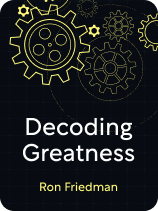

This article is an excerpt from the Shortform book guide to "Decoding Greatness" by Ron Friedman. Shortform has the world's best summaries and analyses of books you should be reading.
Like this article? Sign up for a free trial here.
What would you like to know how to do well? What would you try if you had a plan to succeed?
You could have the best ideas in the world, but they’d amount to nothing without execution. Implementation takes skills, and Ron Friedman shares three strategies for developing skills: practice effectively, track your progress, and mitigate your risks while experimenting and innovating.
Read more to learn how to improve a skill and, ultimately, implement your ideas.
How to Improve a Skill
We’ll explore Friedman’s advice for how to improve a skill, including three tips for effective practice, using metrics to boost performance, and wisely taking the risks required to learn and grow.
Strategy #1: Practice Effectively
If you want to get better at something, it makes sense that you’d need to practice. But Friedman argues that it’s easy to practice incorrectly or inefficiently—so to avoid wasting your time and effort, he offers several guidelines for effective practice.
Practice Tip#1: Reflect on Your Practice
Friedman argues that the most important aspect of effective practice is self-reflection. Keep track of your goals, the practice routines and performance strategies you employ to reach those goals, and your actual performance. Regularly review each of these elements with an active, critical eye to determine which strategies or approaches worked well and which didn’t.
Friedman suggests that journaling is an especially good way to reflect on your practice. He specifically recommends five-year journals, which allow you to make entries for the same date for five consecutive years so that you can review where you were at specific points in the past. In the process, you have a chance to notice relevant patterns that might not be obvious on a day-to-day level.
Practice Tip#2: Challenge Yourself
Friedman also argues that for practice to be effective, it needs to be challenging—it should push you past your current comfortable skill level. If practice is too easy or too repetitive, you stop paying attention to what you’re doing, which halts growth and can harm your performance.
Similarly, Friedman stresses the importance of mixing up your practice so that you don’t fall into routines. The problem, he says, is that if your practice regimen is the same every time, you get bored: Your brain checks out and you stop learning. To avoid this problem, find new ways to develop the same skills, or add new obstacles and challenges to keep things fresh.
Practice Tip#3: Imagine Your Performance Ahead of Time
In addition to physical practice, Friedman recommends that you mentally rehearse prior to your actual performance. To do so, he suggests imagining your performance as specifically as you can, including the time and place, the sensory details you expect to encounter, and the nuances of the behaviors you’ll need to perform.
Friedman argues that this kind of imagery can improve your actual performance in several ways:
- It locks down important details.
- It prepares you for the stressors and challenges you’ll likely face.
- It helps you strategize because you’ll foresee potential problems and find ways to avoid or compensate for them.
Friedman cautions that, when using this kind of imagery, it’s important to imagine your performance, not your success—in other words, imagine the specific behaviors you’ll perform in the kitchen, not how good the food will taste or how proud you’ll feel when serving your guests. He points to a study showing that visualizing success actually makes your performance worse. That’s because when you imagine yourself succeeding, you get an emotional payoff that tricks your brain into thinking you have already succeeded. This payoff lowers your motivation and makes you more complacent, which ultimately makes you less effective.
Strategy #2: Improve Your Performance With Metrics
Another way Friedman says you can improve your performance is to set goals and then develop key metrics to help you track your progress toward your goals. He explains that doing so encourages you to think critically about your goals and how to achieve them.
That’s because metrics force you to break down your larger goal into component steps, behaviors, or milestones. In turn, these milestones help you track your progress and also detect areas where your performance is lagging, which Friedman says allows you to take a strategic approach to improvement.
Friedman warns that, if you do use metrics, you should be careful not to get too focused on metrics for metrics’ sake. He explains that metrics are simplifications, and if you choose your metrics poorly, you might miss important aspects of your behavior or even let your pursuit of numbers distort your actual behaviors and thereby undermine your goals.
Strategy #3: Mitigate Risk When Trying New Things
Getting good at anything requires risk. Creativity and effective practice both require you to stretch yourself. This means that, sooner or later, you’re bound to fail. Friedman explains that this kind of failure is a good thing—it’s how you learn—but he also acknowledges that the possibility of failure can prevent necessary risk-taking if the stakes are too high, such as when failure might damage your reputation or your financial position. The answer, Friedman says, is to lower the stakes of failure by strategically mitigating your creative risks using the following strategies.
Risk Mitigation Tip #1: Find a Test Audience
A test audience lets you try out your new idea and get feedback from your intended audience while you’re still figuring things out and the stakes are low.
Risk Mitigation Tip #2: Sell Before You Create
Friedman suggests finding a way to sell your product or service before you create it (such as by creating a prototype and taking a list of preorders). This technique helps you gauge how much demand there is before you invest your resources.
Risk Mitigation Tip #3: Use an Alias
Friedman suggests working under a pseudonym, stage name, or sub-brand while trying out new ideas. Doing so allows you to experiment without damaging your established reputation, confusing your audience, or creating false expectations.
Risk Mitigation Tip #4: Diversify Your Career
Friedman recommends keeping a day job as a steady source of income that allows you to take more risks outside of work. But he also recommends getting creative in how you leverage your talents to make money. The more you spread yourself around, Friedman explains, the more you diffuse the risk associated with any one venture.

———End of Preview———
Like what you just read? Read the rest of the world's best book summary and analysis of Ron Friedman's "Decoding Greatness" at Shortform.
Here's what you'll find in our full Decoding Greatness summary:
- The secret shortcut to elite performance and creative innovation
- How to reverse engineer someone else's work to create your own
- How to lower the stakes of failure by mitigating your creative risks






